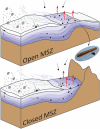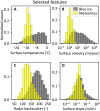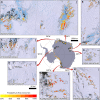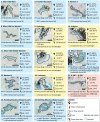Unexplored Antarctic meteorite collection sites revealed through machine learning
- PMID: 35080966
- PMCID: PMC8791461
- DOI: 10.1126/sciadv.abj8138
Unexplored Antarctic meteorite collection sites revealed through machine learning
Abstract
Meteorites provide a unique view into the origin and evolution of the Solar System. Antarctica is the most productive region for recovering meteorites, where these extraterrestrial rocks concentrate at meteorite stranding zones. To date, meteorite-bearing blue ice areas are mostly identified by serendipity and through costly reconnaissance missions. Here, we identify meteorite-rich areas by combining state-of-the-art datasets in a machine learning algorithm and provide continent-wide estimates of the probability to find meteorites at any given location. The resulting set of ca. 600 meteorite stranding zones, with an estimated accuracy of over 80%, reveals the existence of unexplored zones, some of which are located close to research stations. Our analyses suggest that less than 15% of all meteorites at the surface of the Antarctic ice sheet have been recovered to date. The data-driven approach will greatly facilitate the quest to collect the remaining meteorites in a coordinated and cost-effective manner.
Figures







References
-
- Gounelle M., Gounelle M., Meteorites: International law and regulations. Meteorit. Planet. Sci. 54, 2887–2901 (2019).
-
- Bintanja R., On the glaciological, meteorological, and climatological significance of Antarctic blue ice areas. Rev. Geophys. 37, 337–359 (1999).
-
- Hui F., Ci T., Cheng X., Scambos T. A., Liu Y., Zhang Y., Chi Z., Huang H., Wang X., Wang F., Zhao C., Jin Z., Wang K., Mapping blue-ice areas in Antarctica using ETM+ and MODIS data. Ann. Glaciol. 55, 129–137 (2014).
-
- Cassidy W., Harvey R., Schutt J., Delisle G., Yanai K., The meteorite collection sites of Antarctica. Meteoritics 27, 490–525 (1992).
-
- Sinisalo A., Moore J. C., Antarctic blue ice areas—Towards extracting palaeoclimate information. Antarct. Sci. 22, 99–115 (2010).
LinkOut - more resources
Full Text Sources

